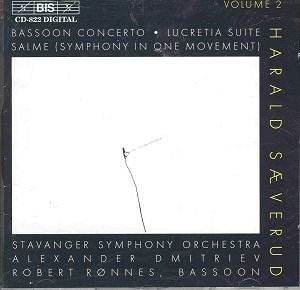The
Bassoon Concerto is given here in its 1980s revision. First
completed in 1964 it was premiered by Jan Høye in Bergen
on 16 April 1964. It then sank from view until the fleet-tongued
bassoonist Robert Rønnes took a reinvigorated interest
in the work. Rønnes even wrote a cadenza for the work and
it is this cadenza that is used in the present recording. The
three movement concerto is in Sæverud's aerated lyrico-atonal
idiom in which the bassoon plays a serenading, cheery and smiling
role rather than the bumbling fool or the prophet of doom although
it does chart some subdued realms during the middle movement.
The
Lucretia-Suite is from three decades earlier. It
is drawn from his music for the first production of André
Obey's play The Rape of Lucretia. This was Sæverud's
first attempt at writing for the theatre. The suite is more closely
attuned to Shakespeare's tragic poem than to Obey's version of
it. After the sour Moderato (tr. 5), comes a Prokofiev-like
gentle 'dance' portraying Lucrece spinning and a contented woodwind
serenade showing her asleep. A doom-heavy Allegro deciso
(tr.8) intimates the people's rebellion and Lucrece's suicide
is suggested. The music would work just as well for a production
of King Lear.
The
Seventh Symphony is from the same year as the Bassoon
Concerto. This is the Salme or Hymn
symphony. It is in one movement and five sections. The chorale
theme is the most melodically approachable on the disc. While
fed through some elliptical processes the theme has the indomitable
power and emotional charge of a Miaskovsky melody (tr.11). It
is accorded some very Russian treatment including bell transformation
as in tr.12 ingeniously woven with some gypsy fiddle playing.
After a fugal episode comes the Glorification. The Seventh
Symphony was written in 1945 when the end of the war was in sight.
The composer dedicated it to his mother and father and gave it
the subtitle: "Symphony of strain, of struggle, of faith and of
gratitude." The hymn of praise rises in epiphanic power in the
towering blaze of the Glorification; once heard not to be forgotten.
Rob
Barnett
